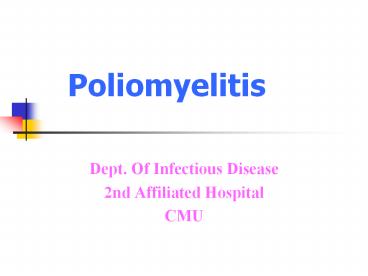Poliomyelitis - PowerPoint PPT Presentation
1 / 35
Title:
Poliomyelitis
Description:
Poliomyelitis Dept. Of Infectious Disease 2nd Affiliated Hospital CMU Definition Poliomyelitis is acute infectious disease caused by poliovirus. Infantile paralysis. – PowerPoint PPT presentation
Number of Views:10514
Avg rating:3.0/5.0
Title: Poliomyelitis
1
Poliomyelitis
- Dept. Of Infectious Disease
- 2nd Affiliated Hospital
- CMU
2
Definition
- Poliomyelitis is acute infectious disease caused
by poliovirus. - Infantile paralysis.
- Pathologic lesions motor neurons in the gray
matter in the anterior horn of the spinal cord.. - Clinical feature
3
Definition
- Clinical feature fever
- sore throat
- muscle pain
- paralysis
4
Etiology
- Causative agent poliovirus
- family Picornaviridae, genus Enterovirus
- single strain RNA
- Resistance Sensitive to heat, oxidant
- ultraviolet rays
5
Etiology
- Serotype
- on the basis of neutralization tests.
- Type I
- Type II
- Type III
- no cross immunity
6
Epidemiology
- Source of infection
- patients and carriers
- inapparent inf. non-paralytic inf.
- Route of transmission
- air-borne, respiratory tract
- fecal-oral route
7
Epidemiology
- Susceptibility
- universal susceptible to polio
- covert infection gt90
- paralytic patientslt1
- lifelong immunity to same type virus
- Epidemiologic features
- children under 5yrs, 6m5yrs
- summer fall
8
Pathogenesis
9
poliovirus
oral
air
epithelial cells (in pharynx, intestine)
covert infection
regional lymphatics
Ab
blood stream
Ab
abortive infection
first viremia second viremia
blood-brain barrier
CNS
paralytic type
non-paralytic type
10
Pathology
- Place of lesion
- all of CNS
- spinal cord, brain stem
- motor neurons in anterior horns of cervical
lumbar enlargement of spinal cord.
11
Pathology
- Pathologic features
- neuron necrosis
- inflammatory infiltrate of leukocyte,lymphocyte.
12
Clinical manifestation
- Incubation period 514 days
- Clinical types
- Covert infection gt90
- Abortive poliomyelitis 48
- Non-paralytic poliomyelitis
- Paralytic poliomyelitis 12
13
Clinical manifestation
- Paralytic poliomyelitis
- Prodromal period
- preparalytic period
- paralytic period
- convalescent period
- sequela period
14
Clinical manifestation
- Prodromal period(14d)
- upper respiratory tact infection
- fever, fatigue, sore throat, headache
- intestinal tract infection
- vomiting, diarrhea, constipation
- abortive poliomyelitis
15
Clinical manifestation
- Preparalytic period
- progressing this phase without prodromal phase
- 16days after symptoms of prodromal phase
- without prodromal phase
16
Clinical manifestation
- Preparalytic period
- fever two-hump fever(1030)
- symptoms signs of CNS
- severe headache vomiting
- dysphoria or lethargy
- muscle pain
17
Clinical manifestation
- Preparalytic period
- symptoms signs of CNS
- cutaneous hyperesthesia
- hyperhidrosis
- meningeal irritations (neck stiffness Kernigs
Brudzinskis signs positive) 36d , nonparalytic
poliomyelitis
18
Clinical manifestation
- Paralytic period
- paralysis types
- spinal type
- brain stem type
- mixed type
- brain type
19
Clinical manifestation
- Paralytic period
- Spinal type most common
- paralysis features
- flaccid (hypomyotonia ,tendon reflexes are weak
or absent) - asymmetric distribution
- without sensory loss
20
Clinical manifestation
- Paralytic period
- Spinal type most common
- paralysis muscles
- paralysis of extremities leg gtarm proximal gt
distal - paralysis of diaphragmatic intercostal muscles
affects respiratory movement - paralysis of abdominal muscle -- stubborn
constipation
21
Clinical manifestation
- Paralytic period
- Brain stem type
- cranial nerve paralysis 710, then 912,
- facial paresis
- dysphagia, high-pitched voice
- respiratory center paralysis
- central respiratory failure
- cacorhythmic breathing ect.
- vasomotor center paralysis
22
Clinical manifestation
- Paralytic period
- brain type - polio-encephalitis
- high fever, convulsion,
- disturbance of consciousness,
- tonic paralysis
- mixed type
- spinal type brain stem type
23
Clinical manifestation
- Convalescent period
- paralytic muscles begin to recover
- distal gt proximal,
- at first 34 month quick recovery, 6 month later
recovery slowly,the recovery process reaches its
limit around 18 months
24
Clinical manifestation
- Sequela period
- persistent paralysis
- muscular atrophies
- deformities of limbs
25
Laboratory Findings
- Cerebrospinal fluid
- aseptic menigitis
- pleocytosis 50500109/L
- protein normal or slightly increase
- albuminocytologic dissociation
- glucose and chloride normal
- virus isolation
pharynx, feces, blood or CSF,brain.
26
Laboratory Findings
- Serological test
- Specific IgM Ab (blood CSF)
- Neutralized Ab
- Complement combining Ab
- four fold rise
27
Diagnosis
- Epidemiological data
- Clinical manifestation
- Laboratory findings
- Abortive or non-paralytic polio - isolation
of virus or serological test
- paralytic polio - clinical diagnosis
28
Differential Diagnosis
- Guillain-Barre Syndrome
- symmetric, ascending paralysis with loss
- of sensation
- CSF protein elevate with absent or
- minimal pleocytosis,
- albuminocytologic dissociation
- rapid and complete recovery
- Coxsackie or ECHO no epidemic no seqela
29
Differential Diagnosis
- Paralysis caused by other enterovirus
- Coxsackie or ECHO viruses
- no epidemic no sequelae
30
Treatment
- Prodromal preparalytic P
- isolation rest in bed
- not accept muscular injection operation
- hot moist pack to muscles
- 50GSVitC 12g iv, IFN
- hydrocortison
31
Treatment
- Paralytic period
- limb paralysis
- nursing for paralytic limbs
- Put the limbs on function position
- Vit C ATP ivdrop
- Galanthamin or Prostipmin iM
32
Treatment
- treatment for respiratory obstacle
- bulbar paralysis
- dysphgia
- keep air way clear (sputum aspiration postural
drainage ) - tracheal intubation
- tracheotomy tank respirator
33
Treatment
- treatment for respiratory obstacle
- respiratory center paralysis
- respiratory stimulant
- tracheotomy tank respirator
- respiratory muscle paralysis
- mild observation
- tank respirator
34
Treatment
- Convalescent sequela period
- acupuncture
- massage
35
Prevention
- control of source of infection
- isolation 40 days after the onset of illness
- protection of susceptible population
- attenuated live vaccine by oral
- killed virus vaccine































